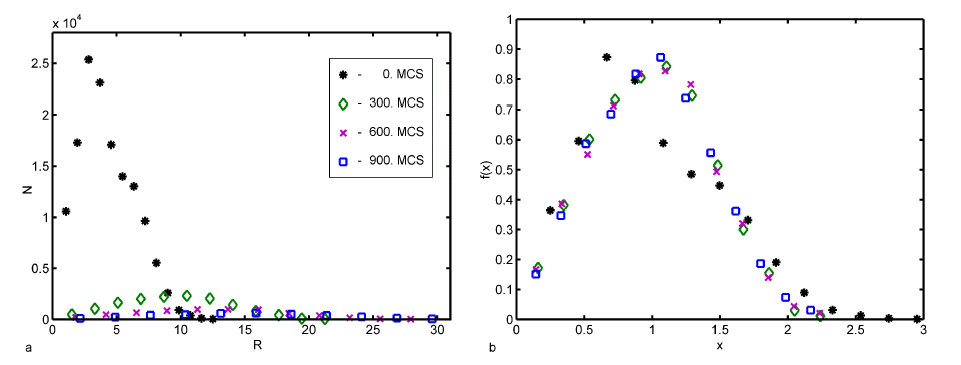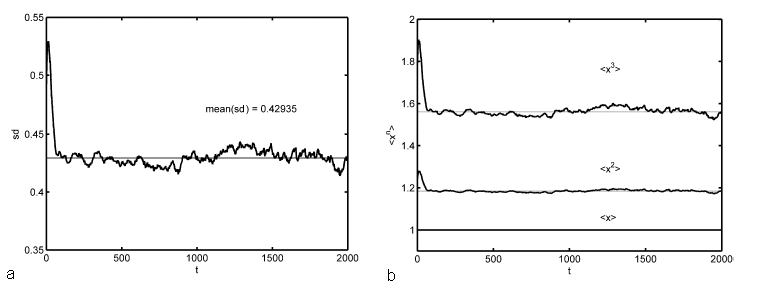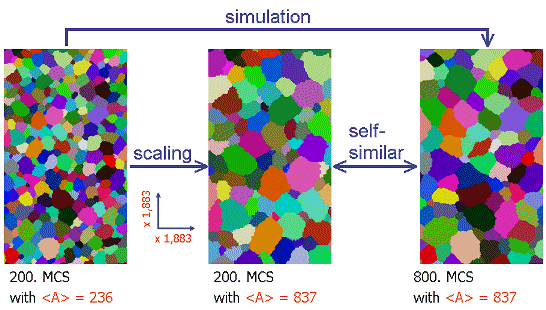|
Self-Similarity |
It is commonly known from experiments that the process of grain coarsening is characterized by an increase in the mean grain size together with a simultaneous decrease in the total inner interface leading to a minimization of the total interface energy. This
is consistent with the well-known growth law for the average grain radius as given by , ,where R is the radius of a grain-volume-equivalent sphere and therefore < R > the average grain size of the assembly of grains, which changes with time t. Consequently < R >0 is the initial mean grain size. The volume of each grain is equal to the number of Monte Carlo Units representing the grain, where a MCU can be imagined as a cube with a length equal to the lattice spacing. The simulated 3D grain structure is supposed to follow after an initial period of time the growth law. The numerical growth factor is b and the growth exponent is n. The latter has an expected value of n = 0.5, which can be found in all three fields of investigation of normal grain growth: experiments, theory and computer simulations. Furthermore, this means that the mean grain area - defined as mean value of the sufaces of all grains calculated as the surfaces of grain-volume-equivalent spheres - increases linearly with time t. It is furthermore known that simulations show this linear relationship between A and t after an initial period of time. This initial period depends strongly on the initial grain structure. While the mean grain area increases to a state, where it changes linearly with time, the underlying coarsening process of the grain structure develops towards a quasi-stationary state that exhibits statistical self-similarity [Burke (1949); Mullins (1986)], which means that the size distribution function F(R, t) in the quasi-stationary self-similar state is characterized by the scaling form  , ,where x is the relative grain size defined as the grain radius of all grain divided by the mean radius of the ensemble.  Figure 1: Simulation of 3D grain ensemble: a - Absolute grain size distributions plotting the number grains versus the grain radius; b - Relative grain size distributions plotting the number grains divided by the total number of grains versus the relative grain radius. Therefore, all grain size distribution functions f(x) within this quasi-stationary self-similar coarsening regime collapse to a single universal, time independent size distribution. This is shown in Figure 1b, where the three time steps out of the quasi-stationary self-similar state indeed coincide. The temporal development of the size distribution however can be seen best by looking at the absolute size distribution, where the number grains is plotted versus the grain radius N(R) (Figure 1a) for four different time steps. One can clearly see the decreasing in the number of grains and the increasing of the grain radii with increasing time. This process develops very fast in the initial period, where most grains vanish, and slower for later time steps. The temporal development of the grain size distribution function can quantitatively be shown through the development of the standard deviation sd (Figure 2a), which is defined by  , ,where is given by  , ,yielding < x > = 1 because x is defined as x := R/< R >. Changes in the grain size distribution function are yielding changes in the standard deviation, whereas a universal, time independent size distribution within the quasistationary self-similar coarsening regime yields a nearly constant universal value for the standard deviation (compare [Wang et al. (2003)]). Therefore, the changes in the grain size distribution also mean changes in the moments and a nearly constant, time independent size distribution yield a nearly constant value for the moments. Because of small numerical fluctuations in the size distribution due to the simulation the moments will also show small fluctuations around an average value. The higher the moment the larger the fluctuations will be. The first moment, the so called scaling property, < x > = 1 is an exception. It yields always the constant value 1 without the numerical fluctuations that characterise all higher moments (cf. Figure 2b).  Figure 2: Simulation of 3D grain ensemble: a - Temporal development of the standard deviation; b - Temporal development of the first, second and third moment. The idea of self-similarity can be better understood by the following: 1. Take from the simulation a grain structure from a random time step t1 (e.g., t1=200). This structure has a certain mean grain size < A >(t1). And we will call it Structure1 2. Now take a grain structure from a later time step t2 (e.g., t2=800) with a higher value of < A >(t2) and call it Structure2. 3. Scale Structure1 in such a way that < A >(t1) = < A >(t2). This does not change the topology or the relative size distribution f(x)! --> It can be concluded that Structure2 and the scaled Structure1 show the same metrical and geometrical properties. Hence, they can be called similar and the feature that the structure is similar with its former or later self (after scaling) is called self-similarity (see Figure 3).  Figure 3: Self-similarity of a 2D grain ensemble: left - structure after 200MCS; middle - scaled structure from left; right - structure after 800MCS. |
| [Burke (1949)] | J.E. Burke. Some factors affecting the rate of grain growth in metals. Transactions of the Metallurgical Society of AIME, 180:73, 1949. |
| [Mullins (1986)] | W.W. Mullins. The statistical self-similarity hypothesis in grain growth and particle coarsening. Journal of Applied Physics, 59:1341, 1986. |
| [Wang et al. (2003)] | C. Wang, G. Liu, and X. Qin. Effect of the initial grain size distribution on the process of grain growth. Journal of Materials Science Letters, 22:473, 2003. |
| [Zöllner (2006)] | D. Zöllner. Monte Carlo Potts Model Simulation and Statistical Mean-Field Theory of Normal Grain Growth. Shaker-Verlag, Aachen, 2006. |
Datenschutzerklärung der Otto-von-Guericke-Universität Magdeburg nach DSGVO